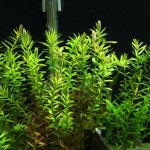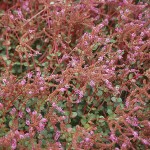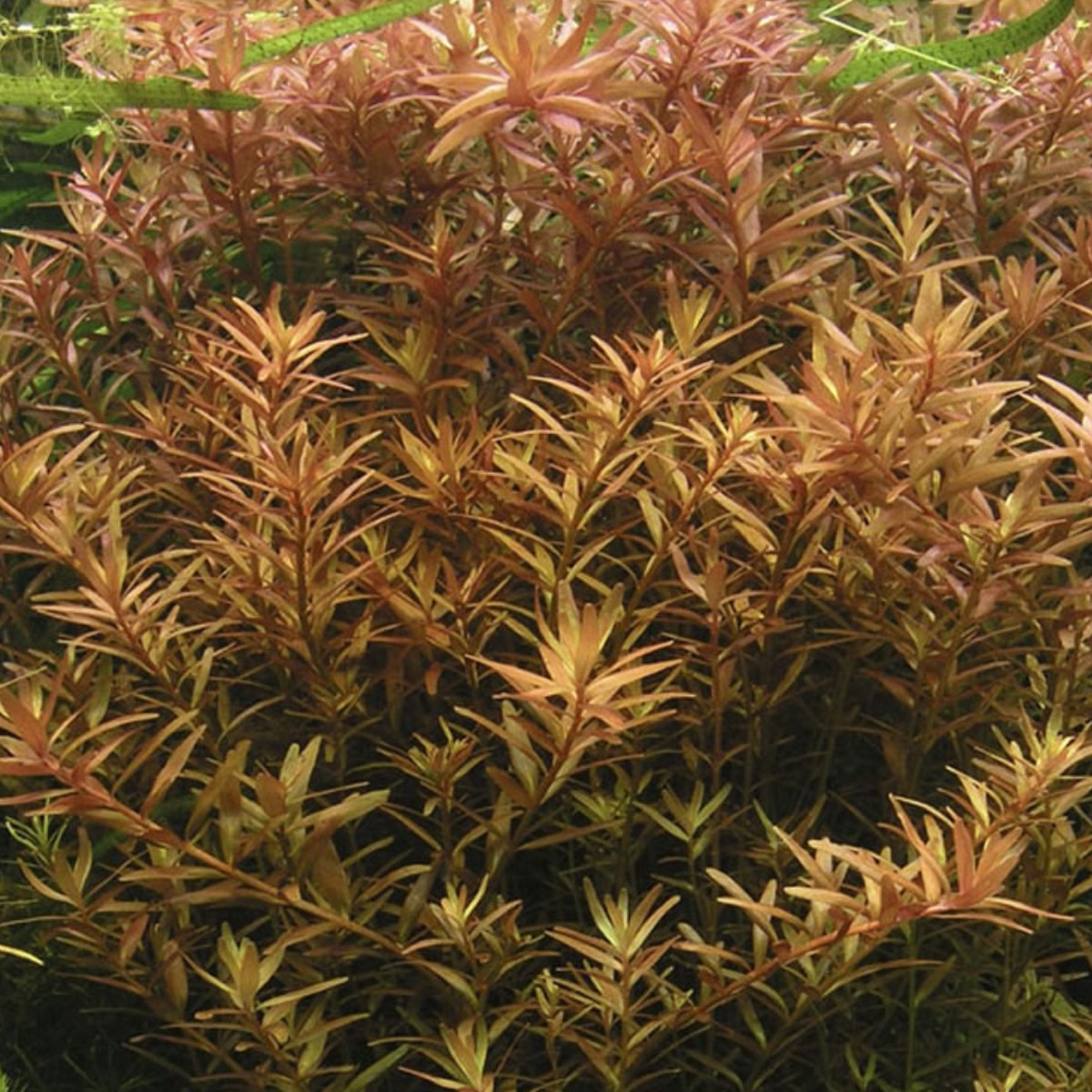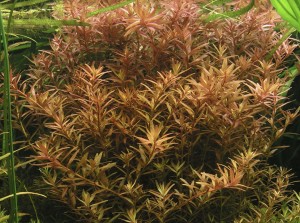Family: Lythraceae
Synonymous: Ammannia rotundifolia
Distribution and habitat: Rotala rotundifolia is an emergent perennial aquatic plant and has its origins in southeast Asia. In the wild, this species is often found in a semi-emersed state at the edges of rice paddies and in moist locations. The current distribution of Rotala rotundifolia has expanded beyond its native range. It was introduced in United stated where it has the potential to become invasive.
Its Latin species name rotundifolia means "round-leaved", however, the round leaves that gave the plant its name are only found in its creeping swamp form. The leaves of Rotala rotundifolia have an elongated oval or even linear shape.
Description: Rotala rotundifolia is a creeping aquatic perennial with soft stems that branch often to form low, creeping clumps. This species has both submersed (underwater) and emergent (out-of-water) forms, which differ in a number of characteristics. The small leaves - less than 2.5cm (1 inch) long - are arranged in groups of two or three around plants' pink stems. However, emergent Rotala rotundifolia has fleshy, bright-green and rounded leaves; submersed Rotala rotundifolia has darker green or reddish leaves that are thin and lanceolate - sword-shaped. Growth habit differs between the forms as well. Low-growing populations of emergent Rotala rotundifolia creep along shorelines and banks, with plant height rarely exceeding 15cm (six inch). Submersed plants form tight, mounded colonies in water as deep as 1.8m (6 feet), but they eventually grow to reach the surface of the water, where they form dense mats that block light penetration and impede water flow. Rotala rotundifolia produces spikes of small, bright pink to fuchsia flowers, but flowering only occurs on plant tips that are aerial or emergent. Flowers occur in spikes at the tip of stems. Plants flower prolifically in spring and early summer.
Rotala rotundifolia can spread by floating stem fragments, which root adventitiously at lower nodes. The plant also produces viable seeds. Fruits are dry capsules that split open to disperse seeds.
Rotala rotundifolia is a favorite of the aquarium and water garden industries, being appreciated for both its leaves and flowers.
Aquarium care: Rotala rotundifolia are ideal aquarium plants for beginners. The species is a typical example of a rapidly growing stem plant and responds favorably to frequent and even heavy pruning. This plant can be used as regulator in a newly cycled tank. Pruning must be done on a frequent basis as the side shots will grow considerably under good condition, keeping the leaves at the base of the plant away from the light. Without pruning, the plant will take a bushy appearance which could be suitable for fry or breeding tanks. Although they are difficult to grow beyond the water surface; established plants will flower small, purple flowers above the water line.
This plant looks best when planted in large groups. Once it is flourishing, it propagates easily through new shoots or cuttings. Rotala rotundifolia is best placed in the middle or in the background of a tank.
Rotala rotundifolia is considered to be a fragile plant that should be excluded from environments with very active or large fish that may damage their fragile stems.
Water: Adaptable, decorative and fast growing, Rotala rotundifolia will tolerate large fluctuations of both pH and General Hardness (GH). Ideally, the pH should be between 5.5 and 7.5, with dH below 15.
Substrate: Rotala rotundifolia can be plated directly on the bottom substrate of the aquarium. The substrate could be plain sand or small granulated gravel. Soil fertiliser is not required to grow this plant successfully.
Rotala rotundifolia is beautiful in clumps, though have to have enough space between stems when planting. Cut plant stem above lead strip with sharp scissors and strip the bottom 4-5cm of leaves from the stem. Individually insert plant into substrate. Take should be taken not to damage the stem. It is recommended to use tweezers to plant Rotala rotundifolia.
Light: Rotala rotundifolia has a green leaf which will turn reddish pink under bright light. Low or medium light will produce a somewhat lanky, yellow-green specimen. This species requires a moderate to high level of light at 3.5 to 5 watts per gallon provided by full spectrum (5000-7000K) bulbs.
Temperature: Rotala rotundifolia is suitable for tropical aquariums with water temperature below 30C (86F), but not lower than 21C (70F).
Feeding: Rotala rotundifolia plant displays the most beautiful colours at a low nitrate level (5 mg/l) and high phosphate and iron/micronutrient levels. Varying fertiliser doses bring colour hues from pink to yellow. Maintaining nitrates below 5 ppm and phosphates above 1 ppm will further enhance this appearance.
Pond care: Rotala rotundifolia is a tropical species and is not considered cold-tolerant. However, emergent populations cultivated outdoors die back after multiple hard freezes during winter and then quickly regrow when spring arrives. So it can withstand relatively cool temperatures. In temperate zones it may even survive mild winters in a pond. Outside of its hardiness zone, Rotala rotundifolia can be cultivated outdoors during the warm months and treated as annual.
It can be grown emerse in shallow water where it will flower. Masses of dainty pink flower spikes are produced Spring through Autumn. It is also capable of producing a heterophyllous growth form - different in form and coulour for aerial leaves compared with the submersed ones.
This plant grows to 15cm (6 inch) in height and usually is placed in water to 20-30cm (8-12 inch) deep.
Light: Rotala rotundifolia will grow in part shade to full sun. It will grow fast in high light conditions - up to one 2.5cm (1 inch) per week.
Rotala rotundifolia enjoys receiving direct light. It will grow adequately in low light compositions, where most of the leaves will remain a bright green. To truly showcase this plants properties, intense light will bring out the rich red and pink tones that can make an aquascape stand out. The more light provided the smaller and more densely packed the leaves will be.
Pond water: Water requirements are not really an issue. Rotala Rotundifolia supports a wide range of water conditions. It thrives in shallow water to 30cm (12 inch) and grows to 15cm (6 inch) in height.
Pond planting: Rotala rotundifolia can be planted directly into pockets of gravel of the pond. For easy maintenance and containing, use a sallow tray or a 25cm (10 inch) pan size to create mass effect. These species can became invasive, so these plants may need to be severely trimmed to keep them tidy. Make sure to take precautions with this plant disposal.
Pond fertiliser: Soil fertiliser is not required for Rotala rotundifolia health. However, iron and NO3 should be present to avoid stunting the plant. Lean NO3 (nitrate) levels, high PO4 (phosphate) levels, with heavy, regular dosing of iron and trace elements in addition to CO2 injection, will produce intense coloration and vigorous growth.
Problems:
When there is inadequate light, the lower parts Rotala rotundifolia may lose their leaves.
Treatment: Improve light exposure.
Companion plants: Rotala rotundifolia looks excellent when mixed in with other low growing bog or marginal plants such as Myosotis scorpioides (Forget-me-not), Mentha spicata (Mentha) or Bacopa monnieri (Bacopa).
Propagation: The propagation of Rotala rotundifolia is easy: simply cut the top half of a strong stem and gently replant it in the substrate after removing any leaves from the last node of the stem. The parent stem will quickly develop new shoots and the newly planted cutting will quickly develop a root system. Over time, this topping process will develop lush, bushy plants.
Note: The tremendous capacity for vegetative regeneration of Rotala rotundifolia is considered as a serious indicator of potential invasive aquatic plant species. Precautions in disposal this plant always should be taken.
This plant has frequently been confused with Rotala indica and is still commonly advertised as such by many retailers. Differences in the inflorescence provide the key to proper identification.
Uses and display: Rotala rotundifolia popularity is increased over time because its ease of cultivation and beautiful growth pattern. Both Dutch and Nature-style aquascapes often feature this versatile plant. Because of its rapid growth and size, this plant is usually placed in background position, but is also wonderful when is used as ascent plant forming a good clump under reasonable conditions.
Under intense light with good micronutrient levels it will acquire a nice pink coloration which will make a nice contrast with other green aquatic plants. It said that Rotala rotundifolia look its best as mass planting.
As pond plant, Rotala rotundifolia can be used for its beautiful flower heads in shallow water or grown as aquatic plant up to 30cm (12 inch) deep.
Aquarium summary:
Environment: freshwater
Height: 5-20cm (2-8 inch) above the surface
Width: 15-36cm (6-14 inch)
Growth rate: fast
Difficulty: easy
Placement: middle to background
Lighting needs: medium to high
Substrate: gravel
Temperature: 22C - 26C
pH: 6.8 7.2
Water Hardness: 150 - 200ppm
Water depth: 5-76cm (2-30 inches)
Hardiness zone: 8-12






